Electrical Engineering (EE) Exam > Electrical Engineering (EE) Questions > A buck converter, as shown in Figure (a) belo...
Start Learning for Free
A buck converter, as shown in Figure (a) below, is working in steady state. The output voltage and the inductor current can be assumed to be ripple free. Figure (b) shows the inductor voltage VL during a complete switching interval. Assuming all devices are ideal, the duty cycle of the buck converter is ________.
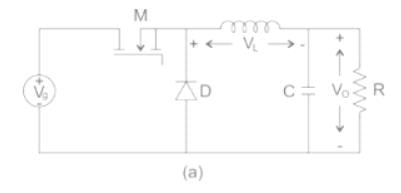
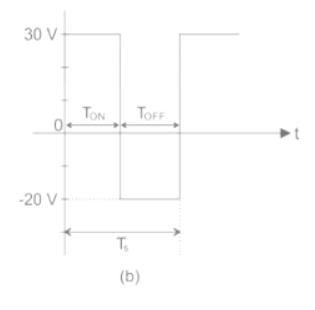


Correct answer is between '0.39,0.41'. Can you explain this answer?
Verified Answer
A buck converter, as shown in Figure (a) below, is working in steady s...
Concept:
Buck converter: It is a switch mode DC to DC electronic converter in which the output voltage will be transformed to a level less than the input voltage. It is also called a step-down converter.

The output voltage of buck converter is given as:
Vo = D Vin
Where,
Vo is the output voltage
Vin is the input voltage
Iin is the input current
Io is the output current
D is the duty cycle
Calculation:
During ON time:
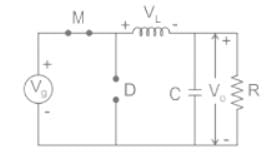

During OFF time:
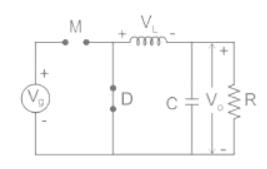
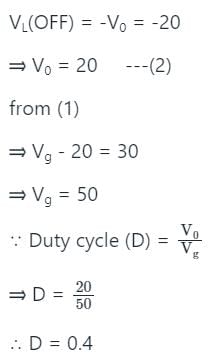

|
Explore Courses for Electrical Engineering (EE) exam
|

|
Question Description
A buck converter, as shown in Figure (a) below, is working in steady state. The output voltage and the inductor current can be assumed to be ripple free. Figure (b) shows the inductor voltageVL during a complete switching interval. Assuming all devices are ideal, the duty cycle of the buck converter is ________.Correct answer is between '0.39,0.41'. Can you explain this answer? for Electrical Engineering (EE) 2025 is part of Electrical Engineering (EE) preparation. The Question and answers have been prepared according to the Electrical Engineering (EE) exam syllabus. Information about A buck converter, as shown in Figure (a) below, is working in steady state. The output voltage and the inductor current can be assumed to be ripple free. Figure (b) shows the inductor voltageVL during a complete switching interval. Assuming all devices are ideal, the duty cycle of the buck converter is ________.Correct answer is between '0.39,0.41'. Can you explain this answer? covers all topics & solutions for Electrical Engineering (EE) 2025 Exam. Find important definitions, questions, meanings, examples, exercises and tests below for A buck converter, as shown in Figure (a) below, is working in steady state. The output voltage and the inductor current can be assumed to be ripple free. Figure (b) shows the inductor voltageVL during a complete switching interval. Assuming all devices are ideal, the duty cycle of the buck converter is ________.Correct answer is between '0.39,0.41'. Can you explain this answer?.
A buck converter, as shown in Figure (a) below, is working in steady state. The output voltage and the inductor current can be assumed to be ripple free. Figure (b) shows the inductor voltageVL during a complete switching interval. Assuming all devices are ideal, the duty cycle of the buck converter is ________.Correct answer is between '0.39,0.41'. Can you explain this answer? for Electrical Engineering (EE) 2025 is part of Electrical Engineering (EE) preparation. The Question and answers have been prepared according to the Electrical Engineering (EE) exam syllabus. Information about A buck converter, as shown in Figure (a) below, is working in steady state. The output voltage and the inductor current can be assumed to be ripple free. Figure (b) shows the inductor voltageVL during a complete switching interval. Assuming all devices are ideal, the duty cycle of the buck converter is ________.Correct answer is between '0.39,0.41'. Can you explain this answer? covers all topics & solutions for Electrical Engineering (EE) 2025 Exam. Find important definitions, questions, meanings, examples, exercises and tests below for A buck converter, as shown in Figure (a) below, is working in steady state. The output voltage and the inductor current can be assumed to be ripple free. Figure (b) shows the inductor voltageVL during a complete switching interval. Assuming all devices are ideal, the duty cycle of the buck converter is ________.Correct answer is between '0.39,0.41'. Can you explain this answer?.
Solutions for A buck converter, as shown in Figure (a) below, is working in steady state. The output voltage and the inductor current can be assumed to be ripple free. Figure (b) shows the inductor voltageVL during a complete switching interval. Assuming all devices are ideal, the duty cycle of the buck converter is ________.Correct answer is between '0.39,0.41'. Can you explain this answer? in English & in Hindi are available as part of our courses for Electrical Engineering (EE).
Download more important topics, notes, lectures and mock test series for Electrical Engineering (EE) Exam by signing up for free.
Here you can find the meaning of A buck converter, as shown in Figure (a) below, is working in steady state. The output voltage and the inductor current can be assumed to be ripple free. Figure (b) shows the inductor voltageVL during a complete switching interval. Assuming all devices are ideal, the duty cycle of the buck converter is ________.Correct answer is between '0.39,0.41'. Can you explain this answer? defined & explained in the simplest way possible. Besides giving the explanation of
A buck converter, as shown in Figure (a) below, is working in steady state. The output voltage and the inductor current can be assumed to be ripple free. Figure (b) shows the inductor voltageVL during a complete switching interval. Assuming all devices are ideal, the duty cycle of the buck converter is ________.Correct answer is between '0.39,0.41'. Can you explain this answer?, a detailed solution for A buck converter, as shown in Figure (a) below, is working in steady state. The output voltage and the inductor current can be assumed to be ripple free. Figure (b) shows the inductor voltageVL during a complete switching interval. Assuming all devices are ideal, the duty cycle of the buck converter is ________.Correct answer is between '0.39,0.41'. Can you explain this answer? has been provided alongside types of A buck converter, as shown in Figure (a) below, is working in steady state. The output voltage and the inductor current can be assumed to be ripple free. Figure (b) shows the inductor voltageVL during a complete switching interval. Assuming all devices are ideal, the duty cycle of the buck converter is ________.Correct answer is between '0.39,0.41'. Can you explain this answer? theory, EduRev gives you an
ample number of questions to practice A buck converter, as shown in Figure (a) below, is working in steady state. The output voltage and the inductor current can be assumed to be ripple free. Figure (b) shows the inductor voltageVL during a complete switching interval. Assuming all devices are ideal, the duty cycle of the buck converter is ________.Correct answer is between '0.39,0.41'. Can you explain this answer? tests, examples and also practice Electrical Engineering (EE) tests.

|
Explore Courses for Electrical Engineering (EE) exam
|

|
Signup for Free!
Signup to see your scores go up within 7 days! Learn & Practice with 1000+ FREE Notes, Videos & Tests.


















